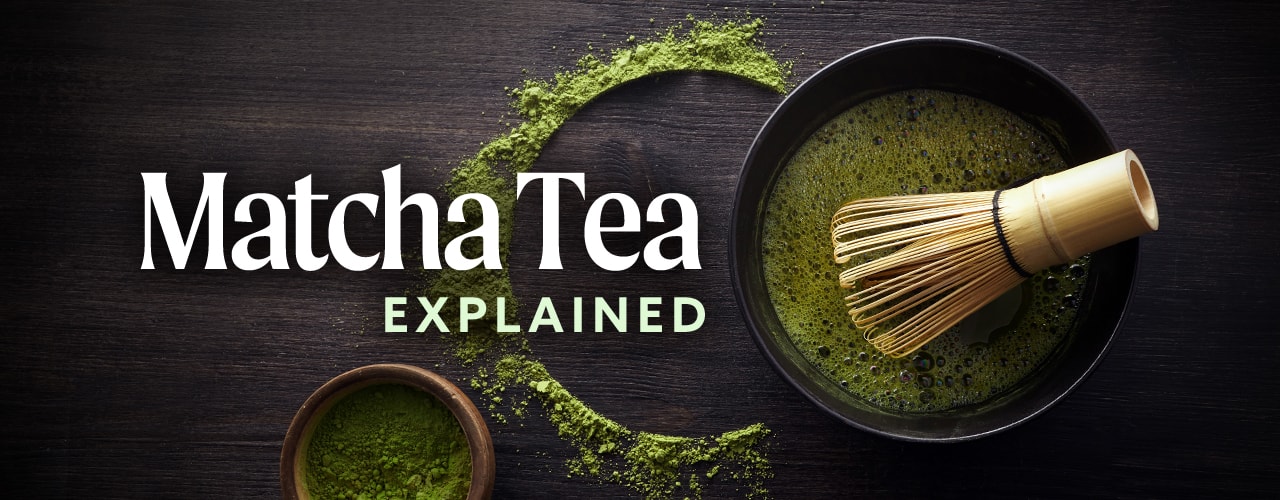Matcha is a finely ground, vibrant green powder made from shade-grown tea leaves. Unlike traditional steeped teas, its unique cultivation and stone-grinding process delivers the leaf's full nutritional content directly into the cup or recipe. This potent powder offers unparalleled versatility, being a premium ingredient in lattes, smoothies, desserts, and savory dishes. Whether you're a seasoned foodservice operator or are just starting your coffee shop, it's easy to utilize the health advantages and culinary applications that make matcha an essential, high-value addition to any modern menu.
Shop All Wholesale TeaHow to Make Matcha Tea
The art of making matcha tea originated from Zen Buddhist monks and was later popularized by the Japanese samurai class as a way of meditating and practicing self-discipline.
How to Prepare Matcha Tea Video
Use the following video to learn how to prepare matcha tea using the traditional method:
Matcha Tea Recipe
To make matcha tea according to the Japanese tea ceremony, you will need the following:
- Matcha Powder
- Hot Water
- Tea Bowl (Chawan)
- Bamboo Matcha Whisk
- Tea Scoop (Chashaku)
Follow these directions to learn how to use matcha powder properly:
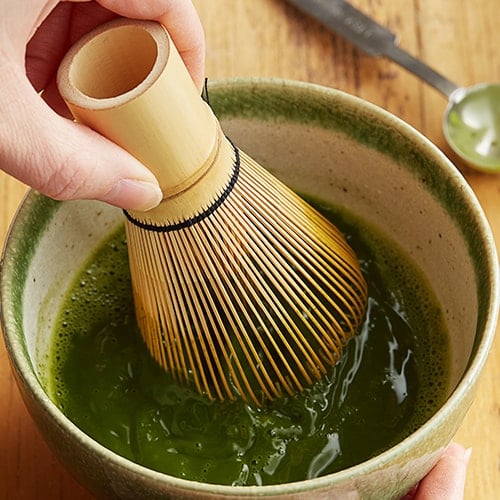
- Fill the tea bowl with hot water to warm the bowl.
- Place the matcha whisk in the water for 30 seconds to loosen the bamboo, then discard the water.
- Scoop approximately 1 tsp. of matcha tea powder in the bowl using your tea scoop.
- Pour 2 oz. of hot water over the matcha powder. The water should be between 160 - 175 degrees Fahrenheit, not boiling. Boiling will burn the matcha and make it bitter.
- Using your chasen, whisk the matcha rapidly and lightly in zig-zag motions instead of traditional circular motions until the powder is fully incorporated.
- Once a foam appears on the surface of your matcha, pull the whisk back in a circular stirring motion.
- Find a quiet spot to sip your matcha tea straight from the chawan or from your favorite mug and quiet your mind.
Be sure to keep your matcha powder in an air-tight container and store it in a cool, dark place to extend the longevity and freshness of your powder. When stored properly, matcha powder can last 4-8 weeks once opened and about a year unopened.
Matcha Bamboo Whisk
A matcha bamboo whisk, or a chasen, is a handcrafted bamboo whisk made specifically for the preparation of matcha. It is traditionally made from a single piece of bamboo and can be found with a varying number of strings or “teeth” on the whisk, anywhere from 16 to 120. The higher the string count, the quicker the matcha foams up. The whisk should be stored in a Kuse Naoshi or a matcha whisk holder to help it retain its shape over time.
How to Make Matcha Tea Without Whisk
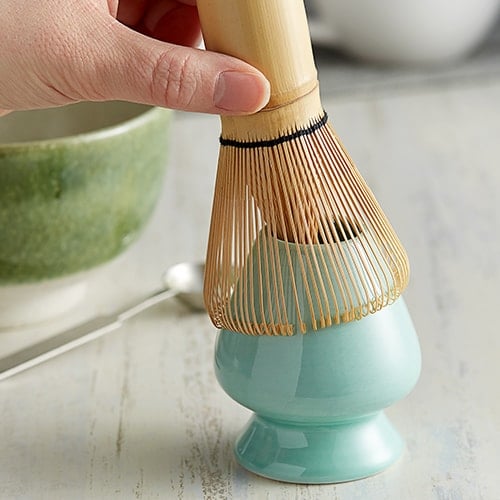
Although it is recommended to use a matcha whisk to achieve the nuances of the matcha tea ceremony, you may not have access to a chasen right away. If you don’t have a matcha whisk, you can try using these alternatives:
- Handheld Milk Frother: Most common alternative but may not provide an even layer of foam
- Blender: Might allow you to incorporate the powder but not fully, may require some hand mixing to finish
- Fork: Does not easily break up clumps and may require prolonged mixing.
How Is Matcha Made?
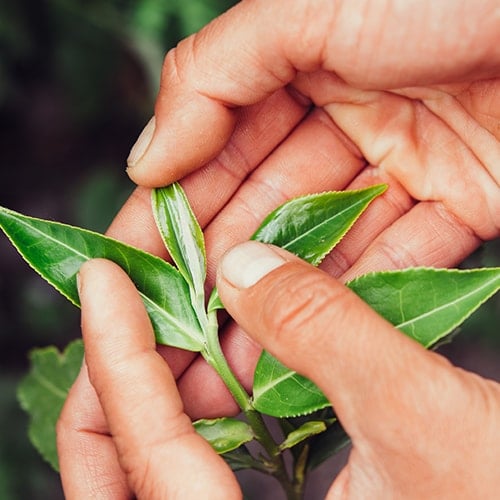
Matcha powder is made by stone grinding specialty green tea leaves into a fine green powder that is vibrant green in color. This powder is then used to make matcha tea. Because the tea leaves are consumed while drinking matcha tea, they need to be grown and picked following very particular specifications. These are the steps that green tea farmers need to take to grow green tea leaves for matcha:
- Shading the Tea Bushes: Before harvest, the plants are covered to filter sunlight. This step boosts chlorophyll for matcha's signature green color and increases amino acids like L-theanine, which are responsible for its smooth, umami flavor and lack of bitterness.
- Hand-Picking the Best Leaves: Only the newest, youngest spring buds and top leaves are selectively harvested by hand. This ensures that only the most tender and nutrient-rich parts of the plant are used, guaranteeing a superior product with complex flavor notes for your beverages and dishes.
- Steaming to Halt Oxidation: The leaves are steamed immediately after picking to deactivate the enzymes that cause oxidation. This preserves the fresh, vegetal flavor and vibrant green hue, preventing the leaves from turning brown and developing an astringent taste common in other green teas.
- Drying and Destemming: The steamed leaves are then carefully dried in a controlled environment and destemmed. This results in pure, fragile leaf fragments called tencha. This is the raw material that will be ground into the final powder, giving the matcha a smooth texture.
- Stone-Grinding into Fine Powder: Once dry, the leaves are slowly stone-ground into a fine powder for matcha tea.
Matcha Tea Benefits
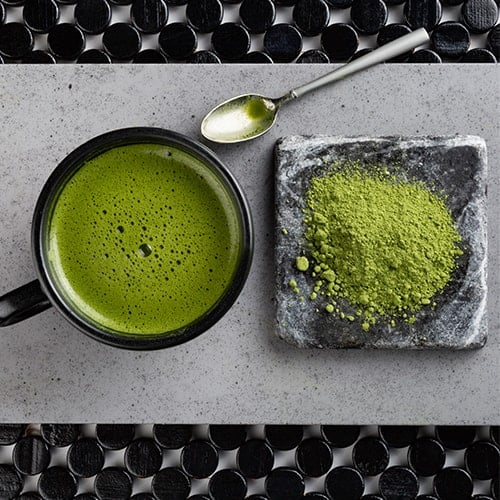
Matcha has joined the ranks of popular cafe and coffee trends around the world because of its appealing health benefits. Here are just some matcha health benefits to consider:
- Protection Against Chronic Disease: Matcha is packed with catechin and polyphenol, antioxidants linked to improved heart health and blood sugar regulation. This allows you to market matcha beverages as part of a wellness-focused lifestyle.
- Metabolic Support: Its high EGCG content may help boost metabolism and aid recovery. Matcha provides a compelling functional benefit for burning body fat, fighting off cold and flu viruses, and recovering from muscle soreness.
- Natural Digestive Cleansing: The high level of chlorophyll helps cleanse the digestive tract and neutralize bad breath, a unique advantage for promoting fresh, health-forward juice.
- Blood Sugar Management: Matcha offers dietary fibers that help prevent insulin spikes, making it an attractive ingredient for menus catering to customers managing their glucose levels.
- Calming Effect: The richness in L-theanine provides a calming effect, differentiating your matcha drinks as a relaxing alternative to the jitters often associated with coffee.
- Sustained Energy and Alertness: Matcha contains caffeine to provide a clean boost of energy, positioning it as a premium, high-functioning energy source for your all-day menu.
Although matcha is associated with various health benefits, there are still a limited number of experiments and research available to prove causation.
Caffeine in Matcha
With the increasing popularity of matcha, it is not surprising that coffee connoisseurs often ask “How much caffeine is in matcha?” Compared to other common caffeine sources, matcha tea typically has more caffeine than green tea but less caffeine than coffee. Here's how matcha caffeine levels compare in an 8 oz. beverage:
- Green Tea: 20-40 mg
- Black Tea: 35-60 mg
- Matcha: 40-75 mg
- Coffee: 80-160 mg
Because matcha also contains L-theanine, the energy boost from the caffeine behaves differently in the body. Unlike the caffeine in coffee, which typically provides a buzzed alertness followed by a crash, the caffeine in matcha creates a calm alertness followed by a sense of relaxation without drowsiness. Those with caffeine sensitivity should still avoid matcha even though the caffeine levels are lower than that of coffee.
Lead in Matcha
One of the main concerns about drinking matcha is the potential for lead to be found in green tea leaves. Green tea plants, or Camellia sinensis, naturally absorb lead from their environment which can end up in drinks like green tea. Various untrusted matcha brands may surpass the acceptable quantities of lead. Be sure to choose reputable and certified brands when purchasing your matcha and limit your intake to around one cup a day. Avoid serving matcha to children.
Back to TopWhat Does Matcha Taste Like?
Matcha has a vegetal flavor with some nuttiness, slight sweetness, and minor bitterness. The flavor of matcha may be impacted by the grade and quality of the matcha. Ceremonial grade matcha will typically have a smoother sweeter flavor with less bitterness while culinary grade matcha is less sweet but features a nuttier flavor. The flavor of matcha can also grow more bitter over time when exposed to oxygen.
Matcha vs Green Tea
Although matcha and green tea both derive from the Camellia sinensis plant, there are some differences that set them apart.
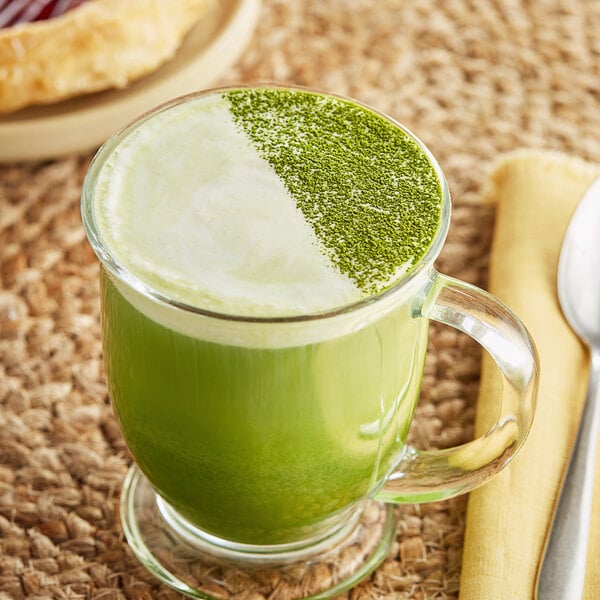
- Complete Leaf Utilization: The fundamental difference between matcha and green tea is that matcha involves consuming the entire leaf in powder form, while green tea is a steeped beverage where the leaves are discarded. Because you whisk the powder directly into water, patrons ingest the whole leaf, receiving 100% of the leaf's available nutrients.
- Sustained Energy Profile: Matcha contains approximately twice the caffeine of steeped green tea, offering customers a more pronounced energy boost. The presence of L-theanine ensures this energy is released without jitters.
- Potent Antioxidant Delivery: Matcha provides a significantly higher concentration of the antioxidant EGCG compared to green tea. This allows you to highlight a stronger functional wellness benefit in your menu items, from lattes to smoothies.
- Maximum Nutrient Yield: The shading process used in matcha production increases chlorophyll and amino acids, resulting in a nutrient density that surpasses standard green tea. This justifies a premium price point and appeals to health-conscious consumers.
- Distinctive Umami Flavor: Matcha offers a unique, naturally sweet, and vegetal taste profile, distinct from green tea's milder, earthier notes. This allows for the creation of signature, complex beverages like the matcha gin fizz that stand out on a menu.
Matcha Powder vs Green Tea Powder
When comparing matcha powder vs green tea powder, you’ll find these differences between the two:
- Color: Matcha powder is a vibrant dark green in color, while green tea powder is often a yellow-brown color. Authentic matcha's vibrant color is a direct indicator of its quality, resulting from shading the tea plants before harvest.
- Leaf Type: Matcha uses only the youngest, shade-grown leaves, which dramatically increases their chlorophyll and L-theanine content. This process is essential for achieving matcha's signature umami flavor and smooth taste, whereas green tea powder from sun-exposed leaves often delivers a harsher, more astringent flavor that can require masking with sweeteners.
- Grind: Matcha powder is made by stone-grinding the tea leaves, green tea powder is made by pulverizing the leaves with air pressure. The process of making matcha results in an ultra-fine powder that helps minimize gritty texture in your beverages and baked goods.
Matcha Grades
There are two main grades of matcha, ceremonial and culinary; however, some list latte grade matcha as a third option. Each grade varies in quality, characteristics, and usage. We explore the matcha grade differences below:
1. Ceremonial Grade Matcha
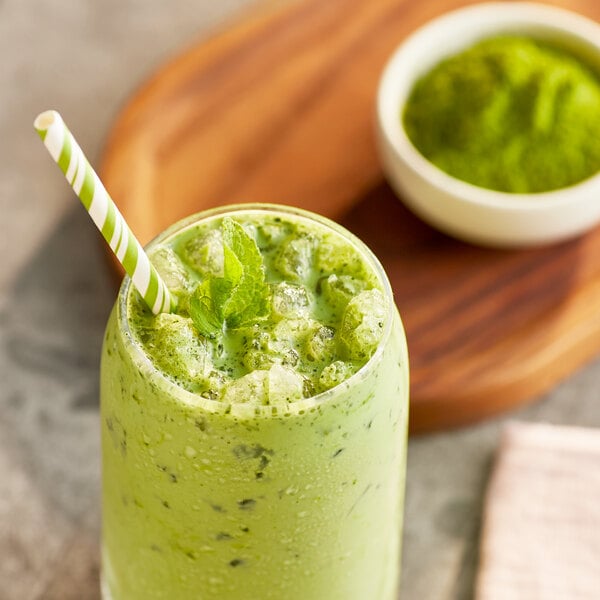
Ceremonial grade matcha is considered the highest quality matcha and is intended to be enjoyed with no additives or sweeteners. It is made with young, shaded green tea leaves that are carefully harvested and processed to create smooth matcha.
- Flavor: A delicate vegetal flavor with mild sweetness and mild nuttiness
- Usage: Used for Japanese tea ceremonies, served with just hot water, reserved for special occasions
- Color: Vibrant Green
- Price: $$$
2. Culinary Grade Matcha
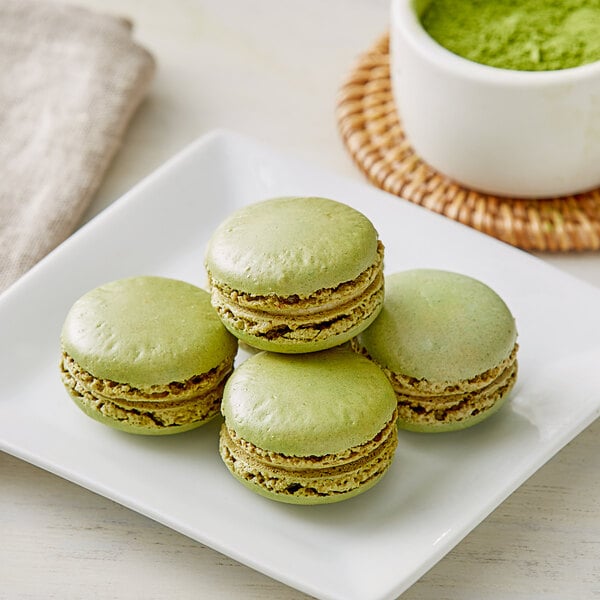
Culinary grade matcha is the most commonly used matcha type. It is made from green tea leaves from the second or third harvest. You will find it used for various cafe beverages and desserts since it is made to be added with other ingredients.
- Flavor: A robust grassy flavor with slight bitter umami flavor and distinguishable nuttiness
- Usage: Brewed and mixed with milk and sweeteners, often used in baked goods, smoothies, cocktails, and other beverages
- Color: Dull Green or Light Green
- Price: $
Types of Culinary Grade Matcha
There are various types of culinary grade matcha that all have their own particular uses:
- Premium Grade Matcha: Fine texture that blends well in hot water, vibrant green in color, great for everyday use
- Classic Grade Matcha: An economic value for everyday usage, features a strong vegetal flavor
- Ingredient Grade Matcha: Thick consistency, pairs well with recipes that contain milk or dairy like desserts or sauces
- Kitchen Grade Matcha: Usually made with mature and less delicate leaves, features a distinct bitter flavor, often added to food recipes like soups, stir-fries, and rich baked goods.
3. Latte Grade Matcha
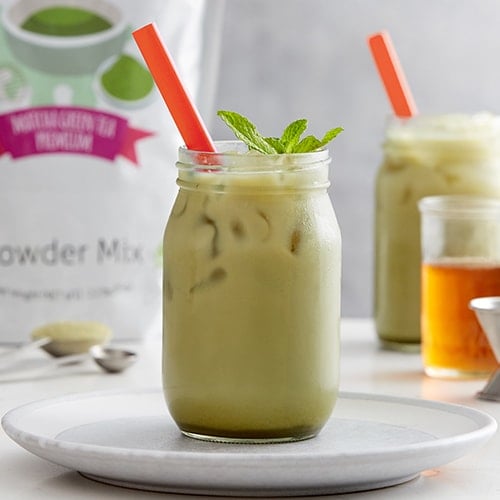
Latte grade matcha, also known as cafe grade matcha, is made from the first harvested green tea leaves and is prepared for steamed milk beverages. It is often included in the types of culinary grade matcha but will more likely be listed as its own grade type.
- Flavor: Strong grassy flavor and mild bitterness
- Usage: Blends well in milk-based beverages and desserts, usually paired with milk and sweeteners, used for hot or iced lattes, like the popular lavender matcha latte
- Color: Green
- Price: $$
Cooking With Matcha
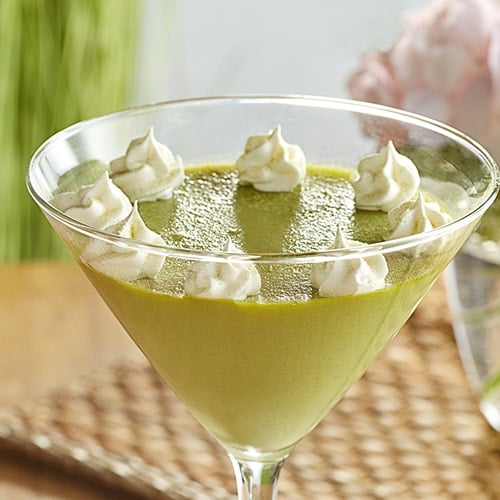
Matcha can transform a basic treat or drink into a vibrant green eye-catching delight. Adding matcha to baked goods and lattes provides an umami flavor that balances well with sweetness and brightens the flavor of savory dishes. Here are just some of the matcha recipes you can try in your cafe or bakery:
- Matcha Cappuccino
- Green Ice Cream
- Matcha Pancakes
- Matcha-Covered Popcorn
- Matcha Cookies
- Matcha Soup
- Green Pudding
- Matcha Salad Dressing
- Matcha Guacamole
Expand your cafe menu by adding some options next to the different types of coffee drinks that you serve. You can try incorporating it in a signature beverage recipe like a strawberry matcha latte, or provide an immersive and relaxing experience by offering Japanese tea ceremonies for your customers.
